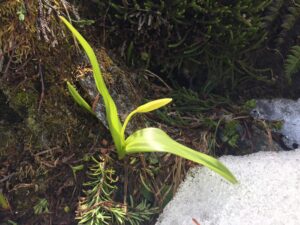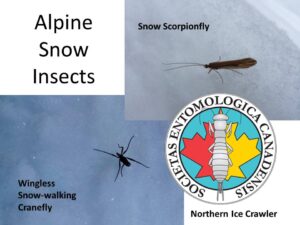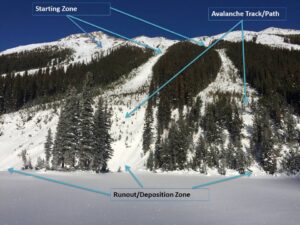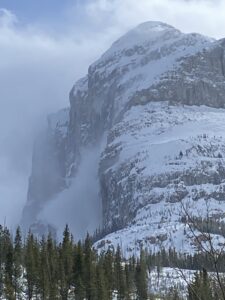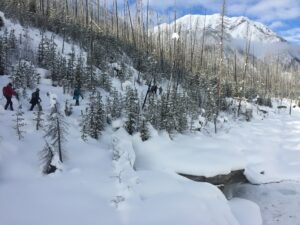By Jenny L. Feick, PhD (All pictures except where noted were taken by the author.)
At this time of year the majority of the Great Divide Trail (GDT) lies blanketed by snow. Although we may feel sad not to be out on the trail right now, the snows of winter provide a valuable period of rest and rejuvenation for the plants and animals in high altitude areas, while avalanche season poses significant danger to human visitors. Since one can potentially experience snow near the Great Divide any month of the year, it’s a good idea to learn something about this magical mineral.
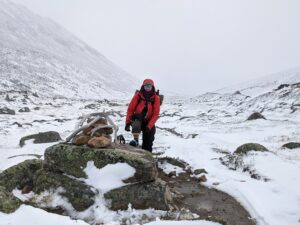
What is this white stuff anyway?
Snow consists of frozen water crystals that grow suspended within clouds when temperatures there sink below the freezing point (0 degrees Celsius, or 32 degrees Fahrenheit). Here, atmospheric water vapour condenses directly into ice without going through the liquid water stage. As each ice crystal forms, it absorbs and freezes additional water vapour from the surrounding air. The ice crystals may grow into clusters called snowflakes, lumpy opaque snow-ice pellets termed grauple, or small translucent mixtures of rain and ice called sleet, which then fall to Earth. Given cold enough conditions, the snowflakes, grauple or sleet accumulates on the ground where they undergo further changes. If on a slope, snow can also slide. Ultimately, the snow melts into liquid water, or sublimates (transitions from a solid to gaseous state) directly into water vapour in the atmosphere.
Indigenous people living in snowy environments have long used a wide array of terms to describe the diversity of snow conditions they encounter as these conditions affect their survival. Snow scientists also use numerous terms to describe different snow formations. By studying snow, how it forms, where it falls, and how the snowpack changes over time, they can better understand how snow affects our planet and our society.
The Beauty and Magic of Snow
A snowy mountain scene looks beautiful as the shapes are often softened and the palette simplified. Snow often looks uniformly white because the surface of clean snow reflects most of the sunlight that hits it. Visible light is white and most or all of the visible light striking snow or ice surfaces gets reflected back without any particular preference for a single color.
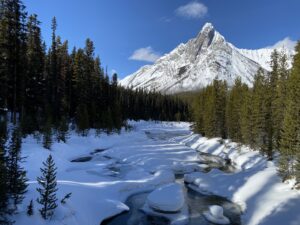
However, snow can appear as other colours depending on circumstances. Snow filters light. As light waves penetrate snow or ice, the ice grains scatter a large amount of light. If light travels over any distance, it must survive many such scattering events. That is, it must keep scattering and not be absorbed. More of the longer-waved lower energy red light gets absorbed by snow and ice than the short-waved high energy blue light. After about a meter (3.3 feet) or more, photons emerging from the snow layer tend to be made up of more blue light than red light and the snow appears bluish in colour. That’s why when you stick your ski pole down into deep snow or dig a snow pit and peer down, it looks blue.
Nevertheless, snow can also appear red or pink in hue. However, this coloration results from a species of cryophilic, or cold-loving, fresh-water algae Chlamydomonas nivalis that contains a bright red pigment. C. nivalis and other chlamydomonads, a group of green algae characterized by single cells with two flagella at their anterior ends, which thrive in very cold, nutrient-poor conditions. Their winter bodies are red, dormant “cysts” that allow them to survive. The red pigment is an adaptation these algae have developed that helps protect them from the intense UV radiation experienced at high elevations and in ecosystems with no shade protection. This “watermelon snow” as it is often called in the Rockies, is usually seen in the summertime in high alpine areas. This pink to red snow may look and even smell appealing. However, harmful bacteria and toxic algae can contaminate snow algae. Consuming large quantities of watermelon snow has caused digestive ailments in the uninformed hiker. If you see it along the GDT, admire its beauty, but don’t eat it, just as you would avoid eating yellow snow.

Most natural materials absorb some sunlight, giving them the colour we see. How much sunlight the snowpack reflects to the atmosphere is characterized as snow’s albedo. The red snow algae as well as dark-colored particles such as dust and soot from forest fires alter more than the appearance of snow. Since they absorb more sunlight, they significantly shorten the duration of snow cover and hasten glacial ice retreat. New snowstorms will bury dust layers, but these darker layers in the snowpack will reemerge as the top ones melt away.
The characteristics and age of snow can affect how sound waves travel, heightening them in some cases, or reducing them in others. You may have noticed that snow may make crunching, creaking, and squeaking sounds. Each layer of snow is comprised of many tiny ice grains surrounded by air. When someone or something steps on snow, these grains get compressed. As the snow compacts, the ice grains rub against each other, creating friction or resistance. Lower temperatures create the most friction among the grains of ice. Sudden squishing of snow at low temperatures produces the well-known crunch, creak or squeak. The colder the snow, the louder the crunch. When temperatures approach the melting point of snow, the grains can easily slide against one another due to the lack of friction. This produces little or no noise.
Have you ever noticed how sound changes after a fresh snowfall? When a thick layer of fresh, fluffy snow falls on the ground and your tent, sound waves get readily absorbed at the snow surface, diminishing sound. That’s one of the reasons that cross-country skiing during or just after a fresh snowfall can feel so peaceful. However, time and weather conditions change the snow surface. As the snow melts and refreezes, it transforms into a smooth and hard surface. This surface then helps reflect sound waves. Under these circumstances, sounds may seem clearer and travel farther than usual.

The Benefits of Snow
There’s a reason why the expression “blanketed by snow” arose. New snow contains a high percentage of air (90-95%) trapped among the accumulated snow crystals. The air can barely move, which reduces heat transfer. During winter, snow provides a protective, insulating layer for the soil, slowing the flow of heat from the ground to the colder air above. The ground is relatively warm since heat stored in it over the summer is slow to dissipate. Snow close to the ground in deeper snowpack is warmer than the upper layers because it is near that comparatively warm ground. The colder the air above, the colder the snow layers near the surface will be, especially within the top 30 to 45 centimeters (12 to 18 inches). If a snowpack consistently retains a depth greater than 15 cm (six in.), the soil temperatures below stay warmer. Ironically, mild winter air temperatures and a lack of snow can cause the exposed ground below to become colder than normal. Without the snowpack’s protection, exposed soils, and plants freeze more readily. This also poses deadly risks for hibernating animals that depend on the insulating effects of snow around their dens to stay warm.
Beneath the snow (sub-nivial in Latin), lies the subnivium, a busy but fleeting microclimate where many plants and animals thrive. There, between the soil below and the icy precipitation above, temperatures hover just above freezing—relatively mild and humid to animals that above the snowpack would face lethally frigid temperatures, high winds, and greater exposure to predators.
The subnivium abounds with life. Microorganisms live out their life cycles. Fungi continue their decomposition functions. Lichens and many plants, including mosses, bearberry, and prince’s pine get enough light transmitted through the snow to remain actively photosynthetic. Some of the flowering plants that one can see along the GDT, including spring beauty, glacier lily, Western anemone, and Indian hellebore, can germinate under the snow.
A remarkable number of animals also carry out much of their lives under the snow, including shrews, many small rodents, porcupines, weasels, and some bird species like ptarmigan. The frosty cloak above protects them. Certain species of small mammals (e.g. voles and shrews) actively forage for food all winter and even reproduce in this sub-niveal environment. These voles and shrews tunnel away at the layer of soil just below the snow, foraging for nuts and berries and hidden insects in the unfrozen leaf litter beneath the snowpack. Voles are particularly active sub-niveal creatures. Their predators, from coyotes and lynx to owls and hawks, have had to evolve acute hearing to pinpoint the exact location of their prey under the snow, and learn specialized hunting techniques not dependent on sight.
While deep snow can impede porcupine travel, making them vulnerable to their main predator, the fisher, snowy drifts provide a steady, mild temperature range for porcupines sleeping in their dens under rock outcrops in forested areas. Willow ptarmigan spend much of the winter on top of the snow but must seek cover beneath its protective blanket when it gets extremely cold and to rest undisturbed. Unlike the grouse that seek shelter in conifers, the remarkable ptarmigan creates cozy snow caves in which to roost. Thirty cm (about 12 in.) down, these birds nestle into a warmer, more comfortable alternative to the frigid surface temperatures.
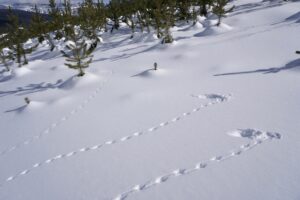
Other mountain plants and animals have special adaptations enabling them to live above the snowpack in winter all the time. Coniferous trees such as subalpine fir and Engelmann spruce that live in the snow forest zone grow tall with short branches that point down, aiding in the shedding of heavy snow. Snow affects ecosystems in varied ways, such as the timing of spring blooms, as well as wildlife migration and survival.

Some creatures have developed specialized feet that help to distribute their weight over a larger area enabling them to travel more easily on top of the snow. Canada lynx and their favourite prey, the snowshoe hare, epitomize this type of adaptation. The large, crescent-shaped hooves of mountain caribou with their distinctive dew clam imprint enable them to search for food in snow-covered areas that would be inaccessible to deer and moose, and to run in deeper snow than their main predators, wolves and cougars. Grouse adjust their seasonal footwear. Every autumn, the chainmail-like scales on their feet develop pectinations. These tiny, bristly projections nearly double each foot’s surface area, making it easier for the grouse to travel on snow. Each spring, these pectinations simply drop off. Ptarmigan have even more protection. Instead of fleshy bumps, the feet of these birds grow expansive feathers that act like insulated snowshoes, increasing both surface area and warmth.

People often consider the dearth of insects as one benefit of snow and winter. However, certain insects and other invertebrates can live on, in, or under snow. One of the most fascinating is the springtail, a type of ancient arthropod known as a hexopod in the class Collembola that has lived on Earth for 400 million years. Although nick-named snow fleas, these miniscule critters are no cousins to the insects called fleas, which evolved 200 million years ago. The only similarity the springtail and the flea have is size. They are both one to two mm long. A springtail doesn’t jump like a flea, using legs. It has a furcula, a tail-like appendage that catapults it nearly 100 times the length of its tiny body. Unlike a flea, it isn’t a parasite. Instead, springtails consume organic matter in the soil, which greatly helps with decomposition. They thus help distribute the nutrients throughout ecosystems and they also help to control microbes. Snow fleas can and do live on snow, though, where they periodically appear in dense colonies. Their cells contain a glycine-rich antifreeze protein that helps them withstand bitterly cold temperatures. Once snow fleas sense snow is starting to thaw, they migrate up from their mud-bound homes to feed on algae and fungi in the snow. They need moist conditions for survival, but amazingly can live without food for years by recycling their own wastes or going dormant. Springtails come in a variety of different colours — purple, red, green springtails exist, although in the vicinity of the GDT the ones you will most likely see in dense colonies on the snow surface are either black or yellow (the golden snowflea). There’s yet another reason to not eat yellow snow.
Another critter you could encounter out on the snows of the Great Divide is the northern ice crawler, Grylloblatta campodeiformis. These omnivorous insects are nocturnal predators and scavengers that actively search for small, invertebrate prey. They also venture onto snowfields, foraging for “insect-fallout” carried and deposited there by wind. Each individual adult is about 30 mm long, just over an inch, and a nice honey beige colour. The first specimen known to science was discovered in Banff National Park in 1913, high on the side of Sulphur Mountain. Ice crawlers will live beside or even right on snowfields. They prefer temperatures of about 0° – 3° Celsius although they can tolerate temperatures of 10-20 °C for short periods. This species is the official insect of the Entomological Society of Canada and appears on the ESC’s crest.
Two insects that often get called snow spiders may also be seen walking on the snow surface on mild winter days, the snow scorpionflies and wingless snow-walking craneflies. Hint: Spiders are arachnids with eight legs. Insects have six legs. These two insects have similar shapes and sizes. However, snow scorpionflies are not true flies (in the order Diptera) whereas the wingless craneflies are, even though they lack wings. Most spiders don’t do winter, although biologists have discovered a few renegade species of long-jawed orb weavers and wolf spiders in the sub-niveum surviving on springtails, craneflies and other insects able to tolerate cold temperatures.
So, the snow that seems to put our lives on the GDT on pause actually sustains the lives of many other living things. While some plant and animal species enter a state of dormancy or hibernation in late fall, others carry on throughout the snowy winter. Most people see a snowy winter landscape as empty and lifeless, but much ecosystem activity goes on below the snow.
Human beings have learned from sub-niveal animals and have used the insulating properties of snow to build snow dwellings in order to protect themselves from harsh winter weather. Even today, winter campers and climbers sometimes dig snow caves to sleep in. Although snow is cold, the air temperature inside a snow cave will stay higher than the exterior air temperature, which tends to plummet significantly at night. With the right sleeping bag and insulated foam pads, winter campers in snow caves often feel cozier than winter tent campers.
When Snow Gets Scary – The Perils of Snow Avalanches
A rapid flow of snow moving down a hill or mountainside is termed an avalanche. Three main parts make up an avalanche: the starting zone, the avalanche track or path, and the runout and deposition zone. The starting zone is the most volatile area of a slope, where areas of unstable snow can detach from the adjoining snow cover and start sliding. Given certain conditions, snow can fracture anywhere on the slope, but usually one finds starting zones high up. The avalanche track or path is the route that an avalanche follows as it heads downhill. If you see large vertical swaths of trees missing from a slope or chute-like clearings, they likely result from frequent large avalanches clearing the way as they race downhill. Avalanches can travel up to 90+ km/hr and many trees get blasted away by the even stronger winds generated in front of the advancing wall of snow and debris., Another telltale sign of avalanche activity is a large pile-up of snow and debris at the base of such slopes. This marks the runout and deposition zone where the snow and debris finally come to a halt.
Snow avalanches pose a significant risk to those who venture forth from November to May near the Great Divide in some of the accessible areas in the mountain parks and Kananaskis Country. Although avalanches can occur on any slope given the right conditions, certain locations, weather conditions, and times of day tend to be more dangerous than others.
The basic ingredients for any avalanche include a mass of snow, a slope for it to slide down, a weak layer in the snow cover and a trigger. Large avalanches get released naturally and relatively harmlessly in natural wild mountainous regions when the snowpack becomes unstable and layers of snow begin to fail. Mountain goats that dwell in these high alpine areas sometimes get killed by avalanches, providing a ready stored of fresh frozen food for hungry bears when they emerge from their winter dens in springtime. Grizzly bears often make their dens near avalanche paths in order to take advantage of this phenomenon as well as the fresh green shoots of willows, the succulent bulbs of avalanche or glacier lilies, and any unwary ground squirrels or marmots still dozy from their long hibernation. Skiers and other winter recreationalists can trigger smaller avalanches that prove deadly for people in the immediate vicinity. After one hour, only one in three victims buried in an avalanche is found alive. The most common causes of death are suffocation, wounds and hypothermia.
Several factors affect the probability of an avalanche, including weather, temperature, slope steepness, slope orientation (i.e., whether the slope faces north or south, east or west), wind direction, terrain, vegetation, and snowpack conditions. Various combinations of these factors generate low, moderate, or extreme avalanche risk. Certain conditions, such as temperature and snowpack, can change on a daily or even hourly basis.
Those engaged in cross-country skiing, backcountry ski touring, snowshoeing, and winter hiking activities need to be aware of the risks and conditions and willing to modify their plans and behavior as the avalanche danger increases. Anyone contemplating a winter trip on the GDT should take avalanche safety training such as those offered by Avalanche Canada, Alpine Club of Canada, and other organizations. To stay safe in backcountry travel in the winter requires more planning, additional skills, the right gear, and more fortitude. Less latitude for error exists. Frostbite, hypothermia, or death by avalanche threaten those who fail to plan and prepare, those whose arrogance and ego overcome their common sense, and those who make mistakes.
The snows of the Great Divide deserve our respect, admiration and appreciation. The ephemeral subnivial microhabitat can be destroyed by the movements of larger organisms overhead. As more people escape the cities to enjoy the many health benefits of outdoor winter activities, the compaction from many footsteps, skis, snowshoes and snowmobiles whittles away the sensitive subnivium. Snow ecosystems are also vulnerable to broader global environmental changes. Places like the Great Divide region characterized historically by snowy, chilly winters tend to be more susceptible to human-caused fluctuations than other places on Earth. Climate scientists expect snow cover to decrease with a warmer climate, melting earlier each spring and sometimes melting and freezing into ice instead of snow. This will affect water supplies and wildlife habitats. As the world warms, climate scientists also expect more extreme less predictable snowfall events, more avalanches, shorter less consistent snow seasons, and less snowy winter weather over time. In response, Sheila Watt-Cloutier wrote The Right to be Cold and many outdoor enthusiasts have come together in the Protect Our Winters movement.
Climate change has already disrupted snow regimes in Western Canada and we can anticipate more significant effects on alpine ecosystems over the coming decades. Those of us hiking and working on the GDT may be among the first to witness and adapt to these effects. The next time you watch snowflakes fall from the sky or look out on a snowy mountain landscape, take a moment to reflect on the beauty, fragility, and importance of snow in shaping the world as we know it, and how in turn, people affect the future of snow.


